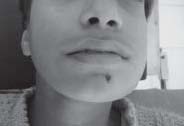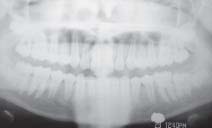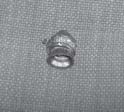INTRODUCTION
Air gun is considered to be a toy for children. However incidents of air gun injuries are quite common. In the US alone, every year more than 30,000 injuries caused by air gun are reported.1 Injuries could appear to be trivial but it may
sometimes cause severe morbidity or even death 2. Air gun injuries, most of time are accidental but could also be result of assaults. The following case report is presented to describe accident that occurred at home & resulted in lodgement of an air gun pallet in the left cheek of 11yr old girl. The management and complication of retained pallet are discussed.
CASE REPORT
An 11yr old girl reported to the department of oral and maxillofacial surgery with air gun injury to the left cheek. At the time of presentation, the child has no symptoms of said injury. History revealed that girl and her sibling were playing at home with air gun four days back. Girl’s siblings were aiming at the target with airgun when girl accidentally came into the range of airgun and was hit by the airgun pallet. She was standing approx. 4m distance from her siblings. She experienced severe pain & was taken to a primary health centre from where she was referred to our institute. Examination revealed a small healed scar on the left side of chin (fig 1). The adjoining skin was depigmented. There was no exit mark visible. No sign of fracture or any other abnormality was detected on both extraoral and intraoral
examination.
The patient was advised OPG to locate the air gun pellet. OPG revealed about 1cm×1cm irregular round radio opaque shadow at the inferior border of mandible near premolar region (fig 2). No other radio opaque shadow made clear that there wasn’t any fragmentation of the pellet. It appeared that pellet had hit the girl with high velocity at an angle and instead of hitting the bone it penetrated the soft tissue of left cheek and got lodged in the left buccal space.
 | Fig 1
 |
 | Fig 2
 |
The patient was advised removal of the pallet. The patients’ father was also explained the consequences of leaving the ragment inside such as, foreign body reaction, soft tissue infection and possible lead poisoning. After obtaining the
informed consent the pellet was removed from the buccal space by extraoral incision under local anaesthesia.
 | Fig 3
 |
 | Fig 4
 |
Approximately 3 cm incision was given at 2 cm below the inferior border of mandible. Blunt and sharp dissection was done along with probing to locate the pallet. The pellet was found to be entrapped in the soft tissue bed (Fig. 3) and was carefully removed without causing any injury to the adjacent vital structures (Fig. 4). Wound was irrigated and closed in layers (Fig. 5). The entry wound was also excised and was closed with 4-0 silk. The patient was regularly followed up and sutures were removed after a period of one week. Postoperative period was uneventful and healing was satisfactory.
 | Fig 5
 |
DISCUSSION
Air gun injuries most of the time are accidental and unintentional, but some injuries could also be a result of assault. In rear cases, air gun could be used as a weapon for suicid3. Depending on the type of airgun, the velocity of the projectile, distance at which it is fired and anatomic site of penetration are the factors that determine the gravity of injury4. Most air gun injuries occur in children. In a retrospective study on 101 children, it was found that 81% victims were male and medium age was 10.9 years3. Air gun injuries in children are generally more severe than adults. The adult skeleton can stop pellet projectiles but thin bone of children can easily be transversed by the projectile to enter the deeper structures5. The anatomic site of pellet entry determines the type and severity of injury. It may range from minor trauma to serious injuries such as corneal perforation, liver laceration, stomach and intestinal perforation, cardiac perforation, aemopneumothorax and even death1. In the head and neck region air gun can cause injury to the eyeball with resultant loss of vision. When the pellet enters the cranium it can cause intracranial bleeding, leakage of CSF, meningitis, brain
abscess, formation of traumatic aneurysm and total carotid cavernous sinus fistula6. Injuries in the facial region can result in pallets being lodged in the jaw bones, paranasal sinuses7 or in soft tissue as in the case presented. When easily accessible surgically such as in the present case the pellets can easily be removed, but when the pellets become embedded in deeper and vital structures, the surgical procedure can be highly invasive resulting in significant morbidity. The projectile from air gun, besides causing immediate and acute trauma can also cause late complications if not removed. In the paranasal sinuses it may cause chronic inflammation, rhinorrhea and neuralgic type of pain8. In a case report, cephalgia of forty years duration was found to be caused by a retained airgun pellet in the maxillary antrum9. Besides, the fragments of the pellet can migrate from the site of entry10.
Retained pellets can also evoke foreign body reaction11. If the pellet material is inert, it may be walled off with fibrous capsule around it12. Lead from the retained bullet can cause lead poisoning ( plumbism), although it is more often reported with gunshot injuries.13,14 Chronic exposure to low levels of lead may lead to learning deficits, changes
in behaviour, short stature, and poor weight gain. The airgun pellets are generally made up of 95% lead, 2.5% tin and 2.5% antimony, 15 therefore the risk of lead poisoning is real. Bowen and Magauran16 reported raised serum levels of lead in 6 cases of ocular injuries caused by airgun pellet. In the reported case, the pellet was embedded in the soft tissue of the cheek. The pellet, if left in situ could cause both immediate and late complications as listed above. As the patient was a young girl the risk of future lead toxicity affecting her physical and mental development was high. Above all, the site of pellet lodgement was easily accessible for surgical removal. Hence in the present case patient was advised surgical removal of pellet.
CONCLUSION
Air gun injuries have a wide clinical presentation from minor injuries to more serious life threatening injuries. Modern air gun muzzle velocity can be as high as that of conventional gun. Therefore, air gun must be considered a lethal weapon and not a mere toy. Strict regulation and public education regarding its potential dangers are required so that air gun injuries can be prevented or at least be minimized.
REFERENCES
1. Naude GP, Bongard FS. From deadly weapon to toy and back again: the danger of air rifles. J trauma 1996;41(6):1039-
43
2. Myre LE, Black RE. Serious air gun injuries in children: update of injury statistics and presentation of five cases. Pediatr Emerg Care 1987;(3):168-70
3. Bratton SL, Dowd MD, Brogan TV, Hegenbarth,MA. Serious and fatal air gun injuries:more than meets the eye. Pediatrics 1997;100(4):609-12
4. Martinez-Lage JF,Mesones J, Gilabert A. Air gun pellet injuries to the head and neck in children.Pediatr Surg Int
2001;17(8):657-60
5. Mrinalini Mahajan,Naseem Shah.Accidental lodgement of an air gun pellet in the maxillary sinus of a 6 year old girl:case report. Dental Traumatolgy 2004;(20):178-180
6. Amirjamshidi A, Abbassioun K, Roosbeh H. Airgun pellet injuries to the head and neck. Surg Neurol 1997;47(4)331-8
7. Lubianca NetoJf,Mauri m, Machado JR, Ceccon A, Paim da cunda C. Air gun dart injury in paranasal sinuses left alone.Int J Pediatr Otorhinolaryngol 2000;52(2):73-76
8. O’Connell JE, Turner NO, Pahor AL. Air gun pellets in the sinuses. J Laryngol Otol 1995;109(11):1097- 100
9. Grevers G, Reiterer A. Traumaticallyinduced foreign bodies of the paranasal sinuses.Laryngorhinootologie 1990;69:155-7.
10. Rapp LG, Arce CA, Mc Kenzie R, Darmody WR, Guyot DR, Micheal DB. Incidence of intera cranial bullet migration.
Neurol Res 1999;21:475-80.
11. Assalita LJ, Delayed foreign body reaction following air gun pellet trauma. J Foot Surg 1991;30:187-9.
12. Ordog GJ, Albin D, WasserbergerJ, Schlater TL, Balasubramaniam S. 110 bullet wounds to the neck. J Trauma
1985;25:238-46.
13. Kikano GE, Stange KC. Lead poisoning in a child after gun short injury. JFam Pract 1992;34:498-500.
14. de- Maduriera PR, de- Capitani EM, Vieira RJ. Lead poisoning after gun shot wound. Sao- Paulo Med J 2000;118:78-80.
15. Steindler RA. Air gun pellet penetration. Med Sci Law 1980;20:93-98.
16. Bowen DI, Magauran DM. Occular injuries caused by air gun pellets: an analysis of 105 cases. Br Med J 1973;1:333-7. |